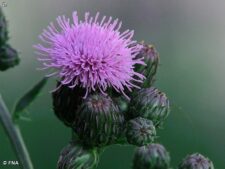
This aggressive naturalized perennial, a native of Eurasia and North Africa, is now widely established worldwide. The erect, spineless, branching stems reach up to 5 feet tall. Its abundant underground rhizomes often extend to form large colonies. Lower leaves are up to 8 inches long with lobed margins and sharp spines at the lobe tips, but the leaf surfaces are smooth. Upper leaves are less deeply lobed, often simply toothed. Numerous small pale magenta to purple flower heads are less than 1 inch long and about 1/2 inch wide. They are clustered at the ends of the branches (A). Short spines are found on the bracts just below the flowers (B). The flower heads of this thistle are much smaller than those of other thistles found in our two nature centers.
Found in open bottomlands, roadsides, and other waste places, flowering from June through August. In Fontenelle Forest it has been seen along lower Camp Gifford road near the railroad tracks. There are extensive populations of Canada Thistle along River Road north of Neale Woods, but it has not been documented at NW to date. Flowering occurs from June to August.
This aggressive thistle, very hard to eradicate once established, is classified as a noxious weed in Nebraska. It is an excellent nectar source, perhaps its only redeeming quality!
Also known as Field Thistle. Canada Thistle is something of a misnomer, as it is not native to Canada.
The content of NatureSearch is provided by dedicated volunteer Naturalists of Fontenelle Forest who strive to provide the most accurate information available. Contributors of the images retain their copyrights. The point of contact for this page is: Roland Barth.

 Identification
Identification